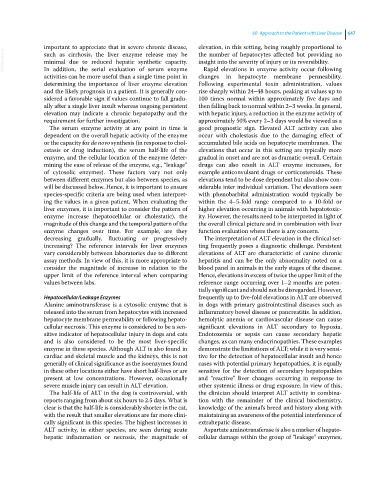Page 679 - Clinical Small Animal Internal Medicine
P. 679
60 Approach to the Patient with Liver Disease 647
important to appreciate that in severe chronic disease, elevation, in this setting, being roughly proportional to
VetBooks.ir such as cirrhosis, the liver enzyme release may be the number of hepatocytes affected but providing no
insight into the severity of injury or its reversibility.
minimal due to reduced hepatic synthetic capacity.
Rapid elevations in enzyme activity occur following
In addition, the serial evaluation of serum enzyme
activities can be more useful than a single time point in changes in hepatocyte membrane permeability.
determining the importance of liver enzyme elevation Following experimental toxin administration, values
and the likely prognosis in a patient. It is generally con- rise sharply within 24–48 hours, peaking at values up to
sidered a favorable sign if values continue to fall gradu- 100 times normal within approximately five days and
ally after a single liver insult whereas ongoing persistent then falling back to normal within 2–3 weeks. In general,
elevation may indicate a chronic hepatopathy and the with hepatic injury, a reduction in the enzyme activity of
requirement for further investigation. approximately 50% every 2–3 days would be viewed as a
The serum enzyme activity at any point in time is good prognostic sign. Elevated ALT activity can also
dependent on the overall hepatic activity of the enzyme occur with cholestasis due to the damaging effect of
or the capacity for de novo synthesis (in response to chol- accumulated bile acids on hepatocyte membranes. The
estasis or drug induction), the serum half‐life of the elevations that occur in this setting are typically more
enzyme, and the cellular location of the enzyme (deter- gradual in onset and are not as dramatic overall. Certain
mining the ease of release of the enzyme, e.g., “leakage” drugs can also result in ALT enzyme increases, for
of cytosolic enzymes). These factors vary not only example anticonvulsant drugs or corticosteroids. These
between different enzymes but also between species, as elevations tend to be dose dependent but also show con-
will be discussed below. Hence, it is important to ensure siderable inter individual variation. The elevations seen
species‐specific criteria are being used when interpret- with phenobarbital administration would typically be
ing the values in a given patient. When evaluating the within the 4–5‐fold range compared to a 10‐fold or
liver enzymes, it is important to consider the pattern of higher elevation occurring in animals with hepatotoxic-
enzyme increase (hepatocellular or cholestatic), the ity. However, the results need to be interpreted in light of
magnitude of this change and the temporal pattern of the the overall clinical picture and in combination with liver
enzyme changes over time. For example, are they function evaluation where there is any concern.
decreasing gradually, fluctuating or progressively The interpretation of ALT elevation in the clinical set-
increasing? The reference intervals for liver enzymes ting frequently poses a diagnostic challenge. Persistent
vary considerably between laboratories due to different elevations of ALT are characteristic of canine chronic
assay methods. In view of this, it is more appropriate to hepatitis and can be the only abnormality noted on a
consider the magnitude of increase in relation to the blood panel in animals in the early stages of the disease.
upper limit of the reference interval when comparing Hence, elevations in excess of twice the upper limit of the
values between labs. reference range occurring over 1–2 months are poten-
tially significant and should not be disregarded. However,
Hepatocellular/Leakage Enzymes frequently up to five‐fold elevations in ALT are observed
Alanine aminotrans ferase is a cytosolic enzyme that is in dogs with primary gastrointestinal diseases such as
released into the serum from hepatocytes with increased inflammatory bowel disease or pancreatitis. In addition,
hepatocyte membrane permeability or following hepato- hemolytic anemia or cardiovascular disease can cause
cellular necrosis. This enzyme is considered to be a sen- significant elevations in ALT secondary to hypoxia.
sitive indicator of hepatocellular injury in dogs and cats Endotoxemia or sepsis can cause secondary hepatic
and is also considered to be the most liver‐specific changes, as can many endocrinopathies. These examples
enzyme in these species. Although ALT is also found in demonstrate the limitations of ALT; while it is very sensi-
cardiac and skeletal muscle and the kidneys, this is not tive for the detection of hepatocellular insult and hence
generally of clinical significance as the isoenzymes found cases with potential primary hepatopathies, it is equally
in these other locations either have short half‐lives or are sensitive for the detection of secondary hepatopathies
present at low concentrations. However, occasionally and “reactive” liver changes occurring in response to
severe muscle injury can result in ALT elevation. other systemic illness or drug exposure. In view of this,
The half‐life of ALT in the dog is controversial, with the clinician should interpret ALT activity in combina-
reports ranging from about six hours to 2.5 days. What is tion with the remainder of the clinical biochemistry,
clear is that the half‐life is considerably shorter in the cat, knowledge of the animal’s breed and history along with
with the result that smaller elevations are far more clini- maintaining an awareness of the potential interference of
cally significant in this species. The highest increases in extrahepatic disease.
ALT activity, in either species, are seen during acute Aspartate aminotransferase is also a marker of hepato-
hepatic inflammation or necrosis, the magnitude of cellular damage within the group of “leakage” enzymes,

